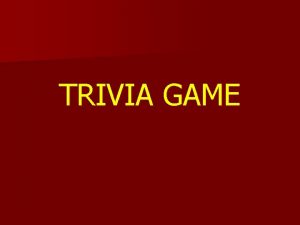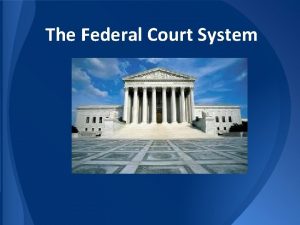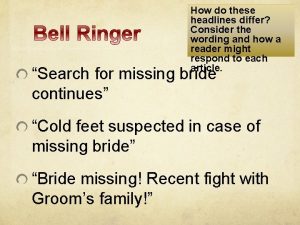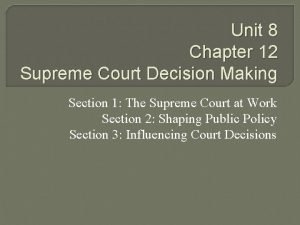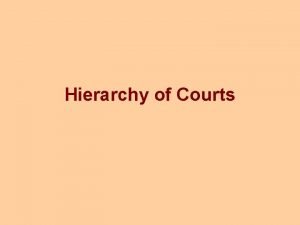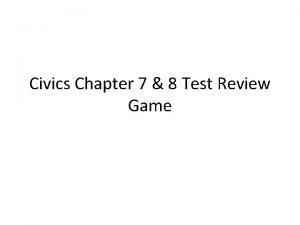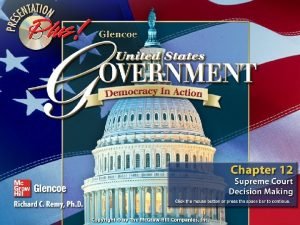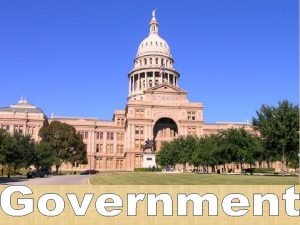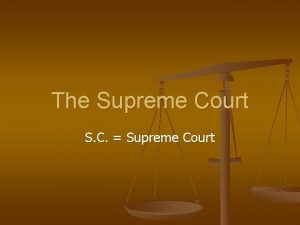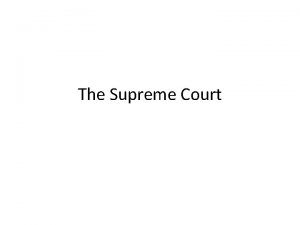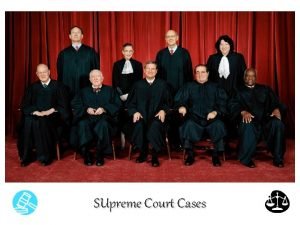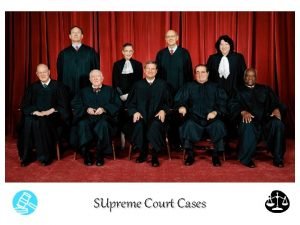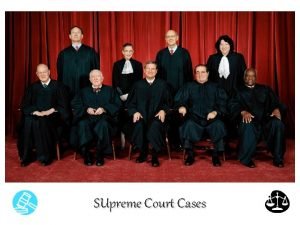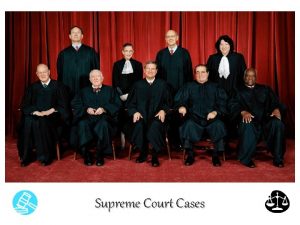Dual Court System Introducing the Supreme Court To










- Slides: 10

Dual Court System & Introducing the Supreme Court To begin…why is “justice blind? ” What is “Rule of Law? ”

Court Hierarchy • Trial courts: Lowest level “courts of first instance; ” original jurisdiction (first court to hear a case); judge or jury • Appellate courts: next level; appellate jurisdiction – reconsidering decisions of trial courts at request of losing party • Supreme Courts or Superior Courts: highest level; appellate or original jurisdiction

The Dual Court System Key Question: Why do we need state courts AND federal courts?

US Court System – DUAL court System STATE COURT SYSTEM FEDERAL COURT SYSTEM • State Court Jurisdiction: Interpret and apply state and local laws – from murder to littering… • Structure varies from state to state; Illinois… • 23 Circuit Courts (arranged by county, lowest level) • 5 Appellate Courts (hear cases on appeal) • Illinois State Supreme Court (court of last resort) • Judges to state courts are elected • US District Courts – original jurisdiction; federal criminal and civil cases; courts to help Congress carry out powers (Tax Court, etc. ) • US Court of Appeals – appellate jurisdiction; review all criminal and civil cases from district courts • US Supreme Court – “court of last resort; ” highest court in the land; original and appellate jurisdiction • Federal Judges are appointed by president

The Dual Court System United States Supreme Court U. S. Court of Appeal (13) Illinois State Supreme Court Federal District Courts (94) Illinois Appellate Court Illinois Circuit Court (22) Local Municipal Courts

Big Ideas about the Judiciary: Striking a Balance with the Courts Rights of the Individual Rights of Society Judicial Activism Judicial Restraint How do these influence the cases the Supreme Court chooses to hear?

How to read a Supreme Court case. Morse v. Frederick (2007) 1. What happened? Case background of Morse v. Frederick 2. Read the decision in Morse vs. Frederick. Underline the main ideas in section A, B and C. What precedent was established in this case?

The Judicial Branch Morse v. Frederick (2007) With your pod… • Identify 3 reasons the students were right in holding their banner. • Identify 3 reasons the school was right for suspending the students. • Identify one key question you think the Supreme Court should have asked while ruling on this case

Justice Steven’s Dissent “Admittedly, some high school students (including those who use drugs) are dumb. Most students, however, do not shed their brains at the schoolhouse gate, and most students know dumb advocacy when they see it. The notion that the message on this banner would actually persuade either the average student or even the dumbest one to change his or her behavior is most implausible. ”

What does this tell us about our big ideas about the judiciary? How effectively do you believe the Supreme Court balanced the rights of the individual against the rights of society in this case? Do you think this ruling represents judicial activism or judicial restraint? Key question: Why choose this case? Submit to Google Classroom Tomorrow…how cases reach Supreme Court, how Court selects cases
 Is there a basketball court above the supreme court
Is there a basketball court above the supreme court Us circuit court map
Us circuit court map What do these headlines say about how the supreme court
What do these headlines say about how the supreme court Vocabulary activity 12 supreme court decision making
Vocabulary activity 12 supreme court decision making The supreme court change
The supreme court change Hierarchy of criminal courts in india
Hierarchy of criminal courts in india The u.s. supreme court works chiefly as a(n)
The u.s. supreme court works chiefly as a(n) Supreme court does
Supreme court does Supreme court does
Supreme court does Have supreme court
Have supreme court Victorian court hierarchy
Victorian court hierarchy
